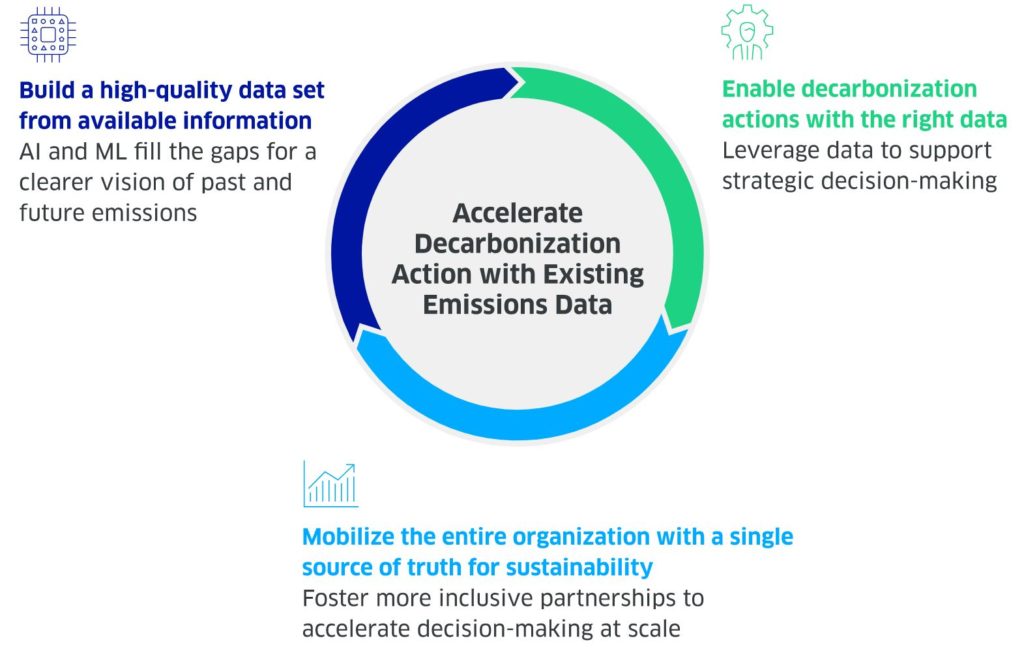As more companies set bold decarbonisation goals such as Science-Based Targets or Net Zero pledges, a major organisational shift is occurring across the global corporate landscape: the topic of carbon is moving from a pure reporting concern to a core strategic concern. The challenge is that the underpinning carbon data is evolving much slower. Many leaders are therefore rightly questioning whether they have the right data to act. It’s not a binary question: act OR gather data. Companies don’t need to wait for perfect data to act.
New technologies like Artificial Intelligence (AI) and Machine Learning (ML) are changing the way organisations think about decarbonisation data. These technologies can model missing data, project future scenarios, and mobilise organisations to move at the pace required to reach Net Zero.
How many times have you wished, “if only we could capture data at every site, for all suppliers”? In reality, it will take some years to deploy the technology and systems to have granular and comprehensive data at scale. And, even if you pull it off, your organisation may not be ready to make the best use of all that data. The good news is that you don’t have to wait for real-time data, or even to have the full breath of carbon data, to make strategic decarbonisation decisions and implement them across regions.
Do more with available emissions data to make faster progress toward your decarbonisation goals in these three steps:
- Build A High-Quality Emissions Dataset from Available Information
Most large organisations have processes in place that enable them to disclose their emissions on an annual basis. But this process can be highly time-intensive and inefficient, taking anywhere from three to seven months to simply calculate the prior year’s emissions. Large companies face a daunting data acquisition challenge in their pursuit of decarbonisation goals. They typically depend on a patchwork of systems. In some locations, they have real-time, asset-level data. But in others, they may only have access to consumption data from monthly electric bills. This process is not only arduous, but it also means that the data used to make decisions will often be at least several months old.
New technologies like AI and ML are enabling organisations to fill these gaps. ML-based algorithms can model missing data and increase the number of facilities companies can analyse to develop their decarbonisation strategy. These tools use available data to model representative sites with similar characteristics (e.g., production environments, climate zones, etc.), building an accurate model of missing data. The same process can also reveal anomalies, catching calculation errors that previously may have gone unnoticed. Using trend data, these technologies can anticipate how emissions will change as the grid evolves or as equipment gets increasingly efficient. With this foresight, organisations can use forward-looking models to inform their strategic decisions.
Many companies we are working with are at early stages of using these tools. The more they can accurately model missing data, the easier it will be for them to get past the data acquisition barrier and develop a sound carbon reduction strategy and evolve it as more data becomes available.
- Enable Decarbonisation Actions with the Right Data
Organisations need better data to enable the strategic actions necessary to meet bold decarbonisation commitments. However not all decarbonisation decisions require the same level of data granularity. In addition to using advanced data techniques, tailoring your carbon data needs can help accelerate decision making and reduce costs.
While advanced decarbonisation actions, such as 24/7 carbon-free energy contracts, require real-time data coupled with sophisticated contracting and decision-making, many other decarbonisation decisions don’t need such granularity. For example, many high-quality clean energy supply contracts can be executed with monthly or even yearly energy procurement data. Similarly, sound asset-level decisions, such as lighting, heating and cooling upgrades, or onsite renewable generation investment, can readily be made using existing operational data. At a company level, meeting annual emissions reductions milestones involves trade-offs concerning which plants to operate and when. Monthly plant-level data, often for the main assets only, is typically sufficient to support the right decisions.
- Mobilize the Entire Organization with a ‘Single-Source of Truth’ for Sustainability
Even if you integrate the right analytical techniques and tailor your data needs to match your decarbonisation ambitions and actions, you may still face challenges mobilizing an entire organisation to deploy decarbonisation strategies at scale. Business units, facilities, finance, operations, procurement, and sustainability functions all have critical roles to play. But they’re often using entirely different data to make decisions. Digital tools can be a vector of change. By offering a single source of truth, these tools can foster more inclusive partnerships across the organisation.
Case Study: Breaking Organisational Silos to Reach Net Zero
We worked with a food company on creating a single source of truth for data for its corporate and plant- level leadership. The company, which has set the target to reach Net Zero emissions by 2040, is heavily reliant on conventional energy supplies for its production and industrial processes across a portfolio of sites. Using data analytics and modelling, we have built a decarbonisation roadmap that aligns company’s sustainability goals with operations at the plants. This is helping the company chart cost-efficient pathways to decarbonisation at each site with clear steps and milestones for deploying and scaling decarbonisation solutions. A data-driven approach and digital tools can help focus the entire organization collectively on projects that move the needle and accelerate the journey to Net Zero.
Leverage Existing Emissions Data To Act Now
The moment has arrived where market pressures, corporate ambition, and technology have converged. Organisations that can effectively leverage existing data sources through advanced analytics, planning, and collaboration will dramatically improve their chances of achieving Net Zero transformation.
This blog post was originally published on https://www.engieimpact.com/insights/accelerate-decarbonization

